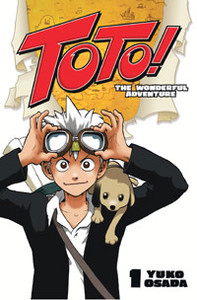Review
by Carl Kimlinger,Toto
GN 1
| Synopsis: |  |
||
As the star of a story whose sub-title is “The Wonderful Adventure,” Kakashi is understandably rather preoccupied with adventure. His late father left him a journal in which he urged his young son to explore the vast world, and Kakashi is desperate to escape his tiny island home in order to do just that. He tries everything, building remarkably crappy rafts and flying machines and hatching mad, dangerous plans. He finally succeeds in smuggling himself off-island in the cargo hold of a zeppelin, where he befriends a lonely puppy. After a mid-air adventure involving weirdly-named bandits (the Man-Chicken Gang?) and anti-aircraft fire, Kakashi and his dog set out for the great beyond. And immediately cross paths with fellow traveler Dorothy, who promptly names Kakashi's puppy Toto and runs afoul of the local militia, who are looking for something that may well be Kakashi's newly-christened canine companion. Finding adventure is the least of Kakashi's worries. |
|||
| Review: | |||
Before you break out the “we're not in Kansas anymore” jokes, you should know that the similarities between Toto and The Wizard of OZ are entirely intentional. Kakashi's name means “scarecrow,” his dog's name is Toto, the first person they meet on the outside is Dorothy, and they're all on their way to a city named Emerald. Of course, this being manga, that's about as far as the similarities go. Kakashi is a feral kid rather than a dopey, dancing straw doll, Dorothy is a master of Tornado Senjutsu martial arts, and Toto transforms into a bipedal mutant mutt the size of a house. If the corruption of a modern fairy tale strikes your fancy, then you may be put off by the fact that it's more seasoning for a standard shounen tale than a raison d'être. Which would be a shame, since it's a darned good standard shounen tale. Rather than sports, fighting, or romance, Yu-Ko Osada is shooting for straight-up adventure—a youth's journey in discovery of himself, if you will. And he hits all of the essential bases for a story of that type: the spunky, likeable lead, the cute, kick-ass female sidekick, and a strong element of the paranormal. The Man Chicken arc that opens the book balances excitement and pathos with aplomb, and Osada's world shows signs of a developing breadth and interest. Fully aware of the genre's reliance on action, Osada's lively art is fast and fun, plowing through shounen tropes such as the obligatory discussions of dreams and personal trauma without bogging down, and fairly sprinting through several furious, dynamic action sequences. He favors bold angular lines and swirls of debris that recall nothing so much as the giant robot destruction of Gainax, and has a taste for dramatic poses, sneers and hatchmarks that leaves his characters oozing punk attitude even in the midst of the most grueling action. The geography of his action sequences is lucid, and he has excellent instincts for when to pause the action with one- or two-page layouts or when to shift it into play-by-play slow-motion. The downing of the zeppelin reads like a punked-up sequence from one of Hayao Miyazaki's aerial films, and Dorothy's rescue of Toto from a band of military punks is a martial-arts smackdown worthy of Naruto. The less action-specific aspects of Osada's art are no less admirable. His eye for dramatic compositions and appropriately off-kilter perspectives is good, and his basic drawing shows skill and care. His layouts are complicated and inventive, but always simple to follow. He often uses page breaks as humorous jump-cuts, and controls timing—in both comedy and action—with blank space, large panels, and pauses between pages. He is rather detail-crazy and shading-shy, so the pages can fill with linework, and he often skimps on backgrounds, preferring to keep the focus on the characters and occasional mecha. Toto is a Del-Rey-standard release—nothing more, nothing less. That means a nice, eleven-dollar-feeling book with translator's notes, a next-volume preview, and Japanese sound effects left in situ accompanied by unobtrusive translations. The translator's notes are skimpy, but it is otherwise a perfectly solid release. Don't read Toto to be surprised, or even impressed—in all likelihood you'll be neither—read Toto to be entertained. It's simple fun, a fine example of what can be achieved by a polished presentation of standard genre fare. And if you're just tuning in to see what Osada is planning to do to The Wizard of OZ, that's fine also. At the very least you won't be bored while you wait. |
| Grade: | |||
|
Overall : B
Story : B-
Art : B+
+ Superior action; fun art; some amusing twists on The Wizard of OZ. |
|||
| discuss this in the forum (4 posts) | | |||
| Production Info: | ||
|
Full encyclopedia details about Release information about |
||